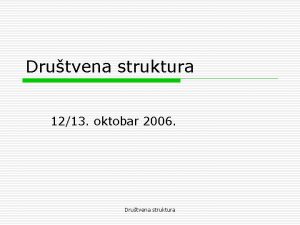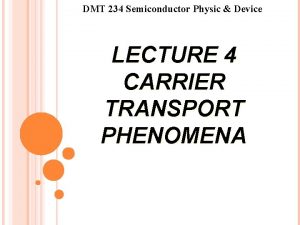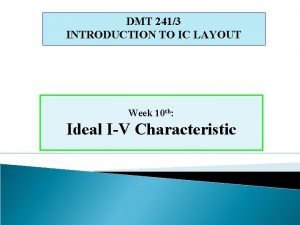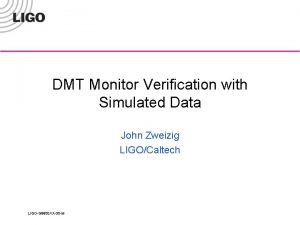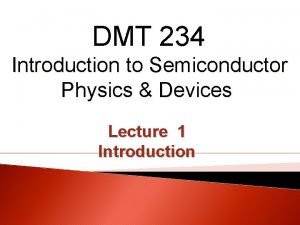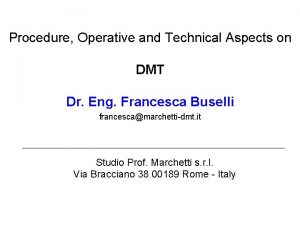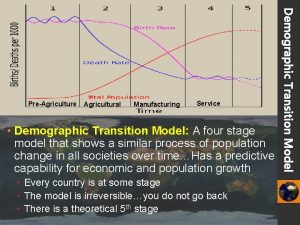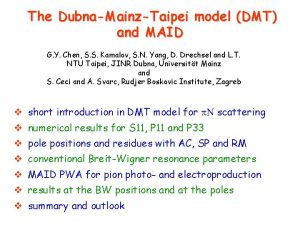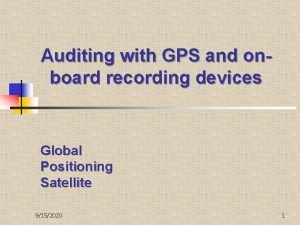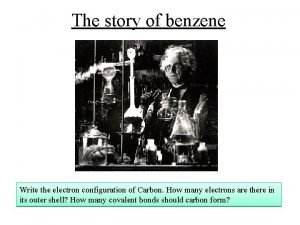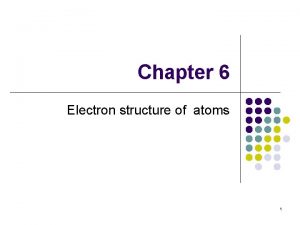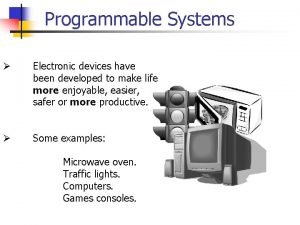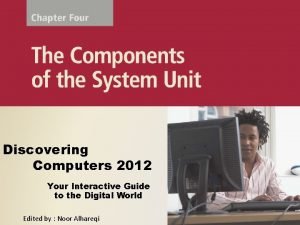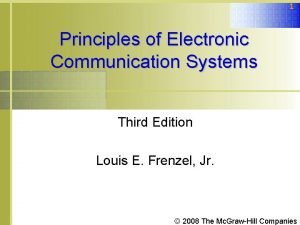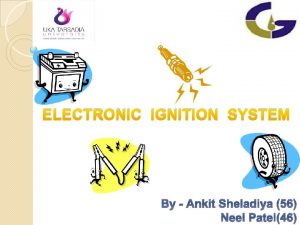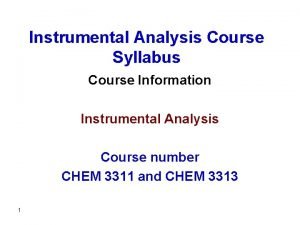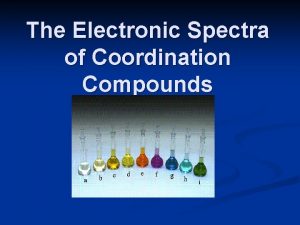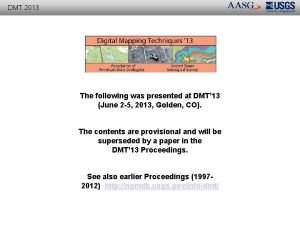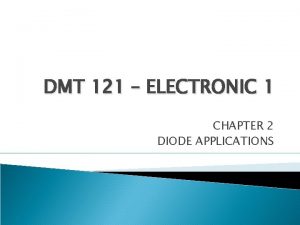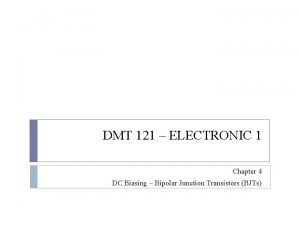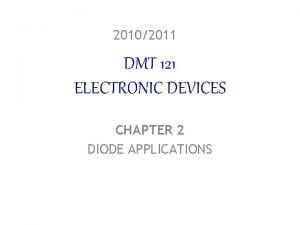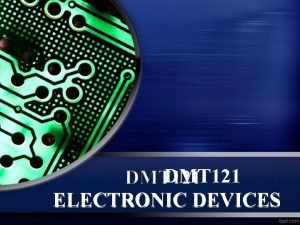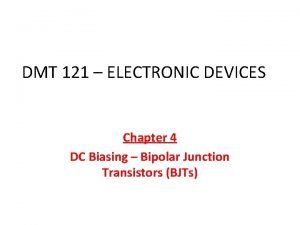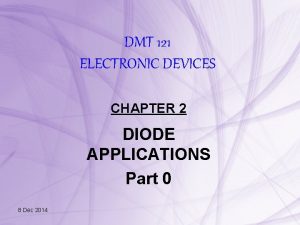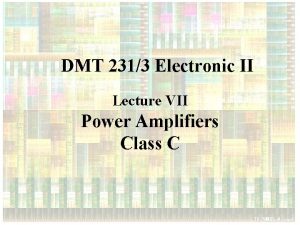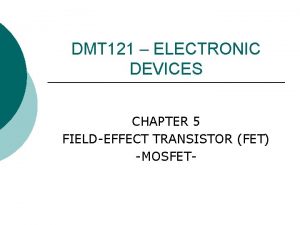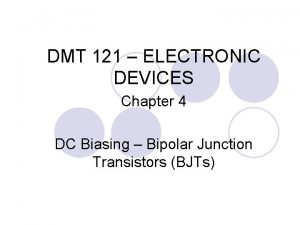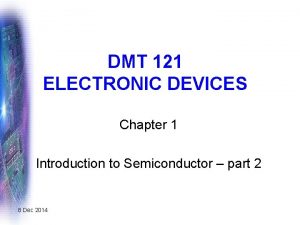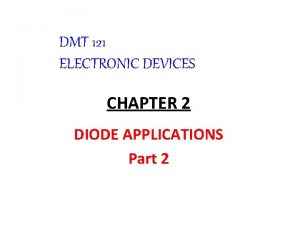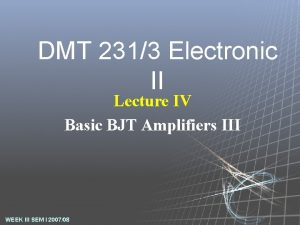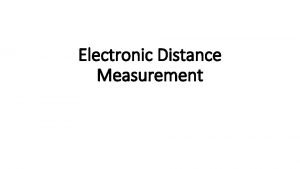DMT 1213 ELECTRONIC I Electronic I DMT 1213







































- Slides: 39

DMT 121/3 : ELECTRONIC I . …Electronic I. …. . DMT 121/3. . Chap. Ter Fo. Ur DC BIASING - BIPOLAR JUNCTION TRANSISTORS (BJTs) 1 Mohd Khairuddin B Md Arshad

DMT 121/3 : ELECTRONIC I Objectives q Discuss the concept of dc biasing of a transistor q Analyze voltage-divider bias, base bias, emitter bias and collector-feedback bias circuits. q Basic troubleshooting for transistor bias circuits. 2 Mohd Khairuddin B Md Arshad

DMT 121/3 : ELECTRONIC I Introduction For the transistor to properly operate it must be biased. There are several methods to establish the DC operating point. We will discuss some of the methods used for biasing transistors as well as troubleshooting methods used for transistor bias circuits. 3 Mohd Khairuddin B Md Arshad

DMT 121/3 : ELECTRONIC I Biasing and the Three States of Operation • Active or Linear Region Operation Base–Emitter junction is forward biased Base–Collector junction is reverse biased • Cutoff Region Operation Base–Emitter junction is reverse biased • Saturation Region Operation Base–Emitter junction is forward biased Base–Collector junction is forward biased 4 Mohd Khairuddin B Md Arshad

DMT 121/3 : ELECTRONIC I The DC Operating Point The goal of amplification in most cases is to increase the amplitude of an ac signal without altering it. 5 Mohd Khairuddin B Md Arshad

DMT 121/3 : ELECTRONIC I The DC Operating Point For a transistor circuit to amplify it must be properly biased with dc voltages. The dc operating point between saturation and cutoff is called the Q-point. The goal is to set the Q-point such that it does not go into saturation or cutoff when an a ac signal is applied. IB IC and VCE IB IC and VCE 6 Mohd Khairuddin B Md Arshad

DMT 121/3 : ELECTRONIC I The DC Operating Point Recall that the collector characteristic curves graphically show the relationship of collector current and VCE for different base currents. With the dc load line superimposed across the collector curves for this particular transistor we see that 30 m. A (IB = 300 A) of collector current is best for maximum amplification, giving equal amount above and below the Q-point. Note that this is three different scenarios of collector current being viewed simultaneously. 7 Mohd Khairuddin B Md Arshad

DMT 121/3 : ELECTRONIC I The DC Operating Point With a good Q-point established, let’s look at the effect a superimposed ac voltage has on the circuit. Note the collector current swings do not exceed the limits of operation (saturation and cutoff). However, as you might already know, applying too much ac voltage to the base would result in driving the collector current into saturation or cutoff resulting in a distorted or clipped waveform. 8 Mohd Khairuddin B Md Arshad

DMT 121/3 : ELECTRONIC I Waveform Distortion FIGURE 5 -6 Graphical load line illustration of a transistor being driven into saturation and/or cutoff…continues at next page 9 Mohd Khairuddin B Md Arshad

DMT 121/3 : ELECTRONIC I Waveform Distortion FIGURE 5 -6 Graphical load line illustration of a transistor being driven into saturation and/or cutoff……… 10 Mohd Khairuddin B Md Arshad

DMT 121/3 : ELECTRONIC I Fixed – Bias (Base Bias) Circuit • Simplest transistor bias configuration. • Commonly used in relay driver circuits. • Extremely beta-dependant and very unstable Fig. 4. 2 Fixed-bias circuit. Fig. 4. 3 DC equivalent of Fig. 4. 2. 11 Mohd Khairuddin B Md Arshad

DMT 121/3 : ELECTRONIC I Fixed Bias (Base Bias) Circuit Fig. 4. 4 Base–emitter loop. Fig. 4. 6 Fig. 4. 5 Base – Emitter loop Measuring VCE and VC. Collector–emitter loop. Collector – Emitter loop VCC – ICRC – VCE = 0 VCE = VCC – ICRC; then = VC – VE since VE = 0 VBE = VB – VE (since VE = 0) VBE = VB Mohd Khairuddin B Md Arshad VCE = VC Since IC = IB, then Sensitive to Beta 12

DMT 121/3 : ELECTRONIC I Emitter Bias • Fig. 4. 17 Use both a positive and a negative supply voltage on emitter or it just contain an emitter resistor to improve stability level over fixed – bias configuration. BJT bias circuit with emitter resistor. Mohd Khairuddin B Md Arshad FIGURE 5 -21 An npn transistor with emitter bias. Polarities are reversed for a pnp transistor. Single subscripts indicate voltages with respect to ground. 13

DMT 121/3 : ELECTRONIC I Emitter Bias – only RE Collector – Emitter loop VCC – ICRC – VCE – IERE = 0 IE I C VCC – ICRC – VCE –ICRE = 0 VCC – VCE = IC (RC + RE) Fig. 4. 17 resistor. BJT bias circuit with emitter Base – Emitter loop VCC – IBRB – VBE – IERE = 0 Since IC = IB, so IC also equivalent to IE = ( + 1) IB Then, VCC – IBRB – VBE – ( + 1)IBRE = 0. Less sensitivity to beta Mohd Khairuddin B Md Arshad 14

DMT 121/3 : ELECTRONIC I Emitter Bias – RE + DC Voltage Supply Collector – Emitter loop + - Base – Emitter loop VEE + IBRB + VBE + IERE = 0 VCC – ICRC – VCE – IERE + VEE = 0 IE I C VCC – ICRC – VCE –ICRE + VEE = 0 VCC – VCE + VEE = IC (RC + RE) Since IC = IB, so IC also equivalent to IE = ( + 1) IB Then, VEE + IBRB + VBE + ( + 1)IBRE = 0. Less sensitivity to beta Mohd Khairuddin B Md Arshad 15

DMT 121/3 : ELECTRONIC I Emitter Bias - summary With DC Voltage supply + Resistor at Emitter With only Resistor at Emitter Previous analysis we use IE = ( + 1) IB; but if use IE IC IB, then from previous slide we can get. If RE >>> RB/ then we can drop RB/ in equation Less sensitivity to beta or independent to beta OR we also can use ( + 1) If VEE >>> VBE then to get the same result. Independent to VBE 16 Mohd Khairuddin B Md Arshad

DMT 121/3 : ELECTRONIC I Example 4. 16 - Boystead Determine VCEQ and IE for the network as shown in Fig. -VEE + IERE + VCE = 0 IE = ( + 1)IB VEE – IBRB – VBE – IERE = 0 IE = ( + 1)IB VCEQ = VEE – ( +1)RE = 20 V – (91)(45. 73 )(2 k ) = 11. 68 m. A IE = 4. 16 m. A 17 Mohd Khairuddin B Md Arshad

DMT 121/3 : ELECTRONIC I Emitter Bias - summary Adding RE to the emitter improves the stability of a transistor. Stability refers to a bias circuit in which the currents and voltages will remain fairly constant for a wide range of temperatures and transistor Beta ( ) values. 18 Mohd Khairuddin B Md Arshad

DMT 121/3 : ELECTRONIC I Voltage Divider Bias • The most widely used type of bias circuit. Only one power supply is needed and voltage-divider bias is more stable ( independent) than other bias types. • Two methods of analysis, exact and approximate analysis Fig. 4. 25 Mohd Khairuddin B Md Arshad Voltage-divider bias configuration. 19

DMT 121/3 : ELECTRONIC I Voltage Divider Bias – Exact Analysis Fig. 4. 27 Redrawing the input side of the network of Fig. 4. 25. Fig. 4. 28 Determining RTH. To determine RTH The voltage source is replaced by a shortcircuit equivalent, resulting……. . RTH = R 1 ǁ R 2 20 Mohd Khairuddin B Md Arshad

DMT 121/3 : ELECTRONIC I Voltage Divider – Exact Analysis To determine ETH The voltage source VCC remained on the network and the open circuit Thevenin voltage can be determined. Fig. 4. 29 Determining ETH. 21 Mohd Khairuddin B Md Arshad

DMT 121/3 : ELECTRONIC I Voltage Divider – Exact Analysis Thevenin network is then redrawn as shown in the Fig. 4. 30, and IBQ can be determined by applying Kirchoff’s voltage law. Fig. 4. 30 Inserting the Thévenin equivalent circuit. ETH – IBRTH – VBE – IERE = 0, …. substitute IE = ( + 1) IB…. . then Almost similar with emitter bias Mohd Khairuddin B Md Arshad Voltage differences over resistance. 22

DMT 121/3 : ELECTRONIC I Voltage Divider – Exact Analysis IC = IB ; IE = ( + 1) IB Substituting between these OR equation in previous slide (from derivation), resulting : Fig. 4. 30 Inserting the Thévenin equivalent circuit. If RE >>> RTH/ , then… Independent to Beta Mohd Khairuddin B Md Arshad 23

DMT 121/3 : ELECTRONIC I Voltage Divider – Exact Analysis Once IB is known, the rest of the parameters can be determined. VCE = VCC – IC (RC + RE) Fig. 4. 25 Voltage-divider bias configuration. The remaining equations VE, VC and VB are also similar as obtained in emitter bias configuration. 24 Mohd Khairuddin B Md Arshad

DMT 121/3 : ELECTRONIC I Voltage Divider – Approximate Analysis and Ri = ( + 1)RE RE with condition Fig. 4. 32 Partial-bias circuit for calculating the approximate base voltage VB. Ri = equivalent transistor between base and ground for transistor with an emitter resistor RE 10 R 2 If beta times the value RE is at least 10 x the value R 2, the approximate approach can be applied with high accuracy. 25 Mohd Khairuddin B Md Arshad

DMT 121/3 : ELECTRONIC I Voltage Divider – Approximate Analysis Once VB is determined, the level of VE can be calculated. VE = VB – VBE And emitter current and IC IE Fig. 4. 32 Partial-bias circuit for calculating the approximate base voltage VB. VCE = VCC –ICRC –IERE but since IE IC VCE= VCC – IE (RC + RE) 26 Mohd Khairuddin B Md Arshad

DMT 121/3 : ELECTRONIC I Collector Feedback Bias (DC Bias with Voltage Feedback) • An improved level of stability can also be obtained by introducing a feedback path from collector to base. • If IC tries to increase, it drops more voltage across RC, thereby causing VC to decrease. When VC decrease, there is a decrease voltage across RB, which decrease IB. The decrease in IB produce less IC which in turn, drops less voltage across RC and thus offsets the decrease in VC. • These feedbacks keep the Q-point stable. IC VRC VC VRB IB VC IC VRC offset the decrease in VC 27 Mohd Khairuddin B Md Arshad

DMT 121/3 : ELECTRONIC I Collector Feedback Bias (DC Bias with Voltage Feedback) Base – Emitter Loop VCC – IC'RC – IBRB – VBE – IERE = 0 Actual case IC' = IC + IB Approximation can be employed : IC' IC = IB and IE IC VCC – VBE - IB (RC + RE) – IBRB = 0 Solving for IB, yields 28 Mohd Khairuddin B Md Arshad

DMT 121/3 : ELECTRONIC I Collector Feedback Bias (DC Bias with Voltage Feedback) Collector – Emitter Loop VCC – IC'RC – VCE – IERE = 0 Approximation can be employed : IC' IC and IE IC VCC – VCE - IC (RC + RE) = 0 VCE = VCC – IC (RC + RE) 29 Mohd Khairuddin B Md Arshad

DMT 121/3 : ELECTRONIC I Troubleshooting Shown is a typical voltage divider circuit with correct voltage readings. Knowing these voltages are required before logical troubleshooting can be applied. We will discuss some of the faults and symptoms. 30 Mohd Khairuddin B Md Arshad

DMT 121/3 : ELECTRONIC I Troubleshooting R 1 Open With no bias the transistor is in cutoff. Base voltage goes down to 0 V. Collector voltage goes up to 10 V (VCC). Emitter voltage goes down to 0 V. 31 Mohd Khairuddin B Md Arshad

DMT 121/3 : ELECTRONIC I Troubleshooting Resistor RE Open: Transistor is in cutoff. Base reading voltage will stay approximately the same. Collector voltage goes up to 10 V(VCC). Emitter voltage will be approximately the base voltage + 0. 7 V. 32 Mohd Khairuddin B Md Arshad

DMT 121/3 : ELECTRONIC I Troubleshooting Base Open Internally: Transistor is in cutoff. Base voltage stays approximately the same. Collector voltage goes up to 10 V(VCC). Emitter voltage goes down to 0 V. 33 Mohd Khairuddin B Md Arshad

DMT 121/3 : ELECTRONIC I Troubleshooting Open BE Junction: Transistor is in cutoff. Base voltage stays approximately the same. Collector voltage goes up to 10 V(VCC) Emitter voltage goes down to 0 V. 34 Mohd Khairuddin B Md Arshad

DMT 121/3 : ELECTRONIC I Troubleshooting Open BC Junction: Base voltage goes down to 1. 11 V because of more base current flow through emitter. Collector voltage goes up to 10 V (VCC). Emitter voltage will drop to 0. 41 V because of small current flow from forward biased baseemitter junction. 35 Mohd Khairuddin B Md Arshad

DMT 121/3 : ELECTRONIC I Troubleshooting RC Open: Base voltage goes down to 1. 11 V because of more current flow through the emitter. Collector voltage will drop to 0. 41 V because of current flow from forward biased collector-base junction. Emitter voltage will drop to 0. 41 V because of small current flow from forward biased base-emitter junction. 36 Mohd Khairuddin B Md Arshad

DMT 121/3 : ELECTRONIC I R 2 Open: Troubleshooting Transistor pushed close to or into saturation. Base voltage goes up slightly to 3. 83 V because of increased bias. Emitter voltage goes up to 3. 13 V because of increased current. Collector voltage goes down because of increased conduction of transistor. 37 Mohd Khairuddin B Md Arshad

DMT 121/3 : ELECTRONIC I Summary Ø The purpose of biasing is to establish a stable operating point (Q-point). Ø The Q-point is the best point for operation of a transistor for a given collector current. Ø The dc load line helps to establish the Q-point for a given collector current. Ø The linear region of a transistor is the region of operation within saturation and cutoff. 38 Mohd Khairuddin B Md Arshad

DMT 121/3 : ELECTRONIC I Summary Ø Voltage-divider bias is most widely used because it is stable and uses only one voltage supply Ø Base bias is very unstable because it is dependant. Ø Emitter bias is stable but require two voltage supplies. Ø Collector-back is relatively stable when compared to base bias, but not as stable as voltage-divider bias. 39 Mohd Khairuddin B Md Arshad
 Drustveno delanje
Drustveno delanje Dmt fabrication
Dmt fabrication Dmt 234
Dmt 234 Physic
Physic Layout dmt
Layout dmt Dmt 234
Dmt 234 Dmt dynasty models
Dmt dynasty models Dmt monitor
Dmt monitor Physic
Physic Dissipation test
Dissipation test Population decline
Population decline Dmt
Dmt Is the electronic exchange of money or scrip
Is the electronic exchange of money or scrip Electronic news gathering and electronic field production
Electronic news gathering and electronic field production Electronic onboard recording devices
Electronic onboard recording devices Pd electron configuration
Pd electron configuration Chapter 6 electronic structure of atoms answers
Chapter 6 electronic structure of atoms answers Ihss contra costa county timesheet
Ihss contra costa county timesheet Keeptruckin dashboard login
Keeptruckin dashboard login Emerson ers
Emerson ers Portable electronic maintenance aid
Portable electronic maintenance aid Magnesium electron configuration
Magnesium electron configuration Electronic mail security in network security
Electronic mail security in network security Electronic etiquette
Electronic etiquette Fax correspondence
Fax correspondence Programmable electronic devices
Programmable electronic devices Electronic service manuals
Electronic service manuals Discovering computers 2012
Discovering computers 2012 Principles of electronic communication systems 3rd edition
Principles of electronic communication systems 3rd edition Advantages of electronic ignition system
Advantages of electronic ignition system Electronic trade documents
Electronic trade documents Instrumental analysis syllabus
Instrumental analysis syllabus Microstate table for p2
Microstate table for p2 Paper medication administration record
Paper medication administration record Electronic forms system
Electronic forms system Electronic card catalog
Electronic card catalog Electronic user's bill of rights
Electronic user's bill of rights Rosterpro
Rosterpro Pengertian surat elektronik
Pengertian surat elektronik Walt downing
Walt downing
